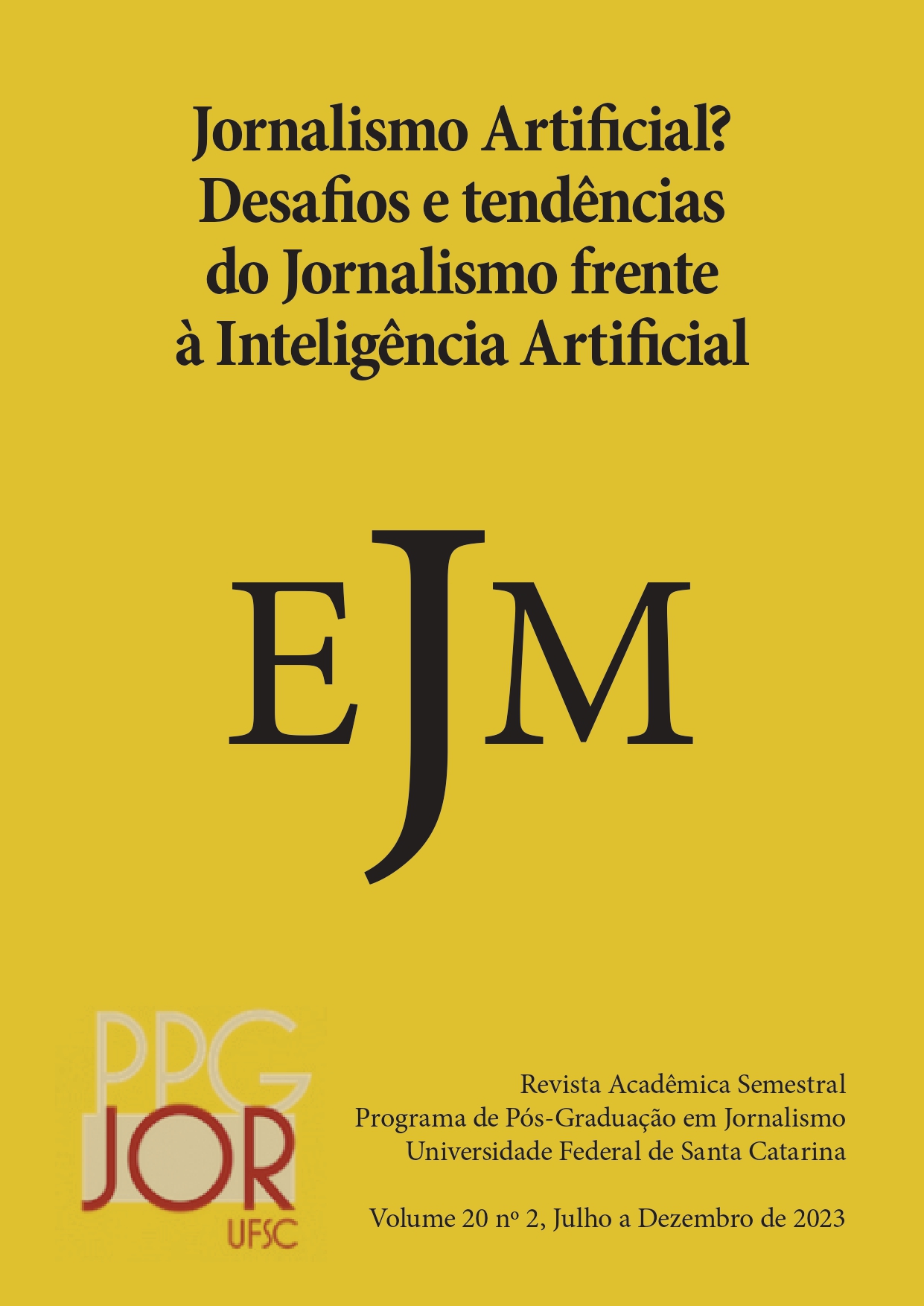Periodismo en un nuevo entorno informativo estructurado por Sistemas Cognitivos Artificiales
DOI:
https://doi.org/10.5007/1984-6924.2023.95083Palabras clave:
Periodismo, Sistemas Cognitivos Artificiales, relevancia socialResumen
El periodismo ha evolucionado, adaptándose para captar la atención del público. Con la aparición de sistemas inteligentes como chatbots y software que transforman datos en narrativas de noticias, surge la Medios Artificiales, sistemas computacionales con sesgo cognitivo que crean contenido en tiempo real a través de una relación interactiva con la audiencia. Este nuevo ecosistema de información difumina las fronteras entre el contenido generado por humanos y el producido por máquinas. La introducción de Sistemas Cognitivos Artificiales establece una asociación simbiótica entre agentes biológicos y artificiales. Esta Interacción de Información Humana reemplaza la relación maestro-esclavo previa de la Revolución Industrial. El artículo sugiere la hipótesis de la consolidación de los Medios Artificiales, en la cual la máquina puede procesar eventos, contextos y acciones, manejando inicialmente situaciones inmediatas y adquiriendo cada vez más capacidades predictivas o prospectivas, remodelando así la producción, distribución y consumo de noticias.
Citas
ALBERS, M. Human-Information Interaction with Complex Information for Decision-Making. Informatics, v. 2, n. 2, p. 4–19, 2015.
C. LEWIS, S.; GUZMAN, A.; R. SCHMIDT, T. Automation, Journalism, and Human-Machine Communication: Rethinking Roles and Relationships of Humans and Machines in News. Digital Journalism, p. 1–19, 2019.
CARLISLE, J. H. Evaluating the impact of office automation on top management communication. National Computer Conference and Exposition. Anais...1976
CHEN, M.; HERRERA, F.; HWANG, K. Cognitive Computing: Architecture, Technologies and Intelligent Applications. IEEE Access, v. 6, p. 19774–19783, 2018.
DEUZE, M. What Journalism Is ( Not ). Social Media + Society, p. 1–4, 2019.
E. KELLY III, J.; HAMM, S. Smart Machines: IBM’s Watson and the Era of Cognitive Computing. New York: Columbia Business School, 2013.
FIDEL, R. Human Information Interaction?: An ecological approach to information behavior. London, England: MIT Press, 2012.
FORSYTHE, C.; BERNARD, M. L.; GOLDSMITH, T. E. Cognitive System: human cognitive models in Systems Design. Mahwah, New Jersey: Lawrence Erlbaum Associates, Inc., Publishers, 2006.
GRIFFITH, D. Beyond Usability: The New Symbiosis. Ergonomics in Design: The Quarterly of Human Factors Applications, v. 13, n. 3, p. 30–34, jun. 2005.
GRUDIN, J. A moving target: the evolution of human-computer interaction. In: JACKO, J. A. (Ed.). . The Human-Computer Interaction Handbook: Fundamentals, Evolving Technologies, and Emerging Applications. 3rd. ed. [s.l: s.n.]. p. 2.
GYNNILD, A. Journalism innovation leads to innovation journalism: The impact of computational exploration on changing mindsets. Journalism, v. 15, n. 6, p. 713–730, 2014.
LEV MANOVICH. The Language of New Media. Cambridge, MA, USA: MIT Press, 2002.
LICKLIDER, J. C. R. Man-Computer Symbiosis. IRE Transactions on Human Factors in Eletronics, p. 4–11, 1960.
LICKLIDER, J. C. R. Libraries of the future. [s.l.] MIT PRESS, 1965.
MARCHIONINI, G. Human- information interaction research and development. Library {&} Information Science Research, v. 30, p. 165–174, 2008.
MCSHANE, M. Natural Language Understanding (NLU, not NLP) in Cognitive Systems. AI Magazine, v. 38, n. 4, p. 43–56, 2017.
PAVLIK, J. V. Computing, Algorithms and Data: Transforming Journalism and MediaII Encontro Internacional de Tecnologia, Comunicação e Ciência Cognitiva (EITCCC), 2016a.
PAVLIK, J. V. Cognitive computing and journalism: implications of algorithms, artificial intelligence and data for the news media and society. Brazilian Journal of Technology, Communication, and Cognitive Science, v. 4, n. December 2016, p. 1–14, 2016b.
SARACEVIC, T. Relevance: A Review of the Literature and a Framework for Thinking on the Notion in information Science. Part II: Nature and Manifestations of Relevance. Journal of the American Society for Information Science and Technology, v. 58, n. 13, p. 1915–1933, 2007.
SCIFORCE. NLP vs. NLU: from Understanding a Language to Its ProcessingSciforce Blog, 2019. Disponível em: <https://medium.com/sciforce/>.
SHAPIRO, I. Why democracies need a functional definition of journalism now more than ever. Journalism Studies, v. 15, n. 5, p. 555–565, 2014.
SILVA, J. R.; LIMA JUNIOR, W. T. From Licklider to cognitive service systems. Brazilian Journal of Technology, Communication, and Cognitive Science, v. 5, n. 1, p. 13, 2017.
SINGH, S. Natural Language Processing for Information Extraction, 2018.
SPENCE, P. R. Searching for questions, original thoughts, or advancing theory: Human-machine communication. Computers in Human Behavior, v. 90, p. 285–287, 2019.
SPERBER, D.; WILSON, D. Relevance: Communication and Cognition. Second Edi ed. Cambridge, MA, USA: Blackwell, 1995.
TAYLOR, J. G. Cognitive computation. Cognitive Computation, v. 1, n. 1, p. 4–16, 2009.
VERNON, D. Artificial Cognitive Systems: a primer. Cambridge, Massachusetts: MIT Press, 2014.
Descargas
Publicado
Número
Sección
Licencia
Ao encaminhar textos à revista Estudos em Jornalismo e Mídia, o autor estará cedendo integralmente seus direitos patrimoniais da obra à publicação, permanecendo detentor de seus direitos morais (autoria e identificação na obra), conforme estabelece a legislação específica. O trabalho publicado é considerado colaboração e, portanto, o autor não receberá qualquer remuneração para tal, bem como nada lhe será cobrado em troca para a publicação. As ideias e opiniões expressas no artigo são de exclusiva responsabilidade do autor, não refletindo, necessariamente, as opiniões da revista. Citações e transcrições são permitidas mediante menção às fontes. A revista Estudos em Jornalismo e Mídia está sob a Licença Creative Commons



